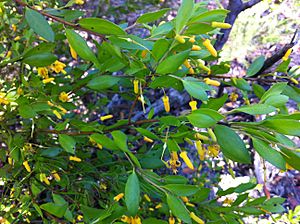Persoonia oblongata facts for kids
Quick facts for kids Persoonia oblongata |
|
|---|---|
 |
|
| Persoonia oblongata in Yengo National Park | |
| Scientific classification | |
| Genus: |
Persoonia
|
| Species: |
oblongata
|
| Synonyms | |
|
|
Persoonia oblongata is a special plant that belongs to the plant family called Proteaceae. You can only find it growing naturally in New South Wales, Australia. This plant is a shrub that can stand tall or spread out. It has leaves that are shaped like narrow ovals or wider eggs. Its pretty yellow flowers grow on long, curved stalks. You can spot this plant in places like the lower Blue Mountains and west towards Rylstone.
What Does It Look Like?
The Persoonia oblongata is a shrub that can grow upright or spread out. It has smooth bark and its new shoots are a bit hairy. Its leaves can be narrow and oval-shaped, or wider like an egg. They are usually about 15–60 mm (0.6–2 in) long and 4–25 mm (0.2–1 in) wide.
When the leaves are young, they might have some hairs. But as they get older, they become smooth (this is called glabrous). Both the top and bottom sides of the leaves are the same color.
The flowers grow either by themselves or in groups of up to sixteen. These groups can be on a main stem (called a rachis) up to 180 mm (7 in) long. Each flower sits on its own smooth, curved stalk (a pedicel) that is 9–23 mm (0.4–0.9 in) long.
Each flower has four hairy parts called tepals, which are like petals. They are 110–12 mm (4–0.5 in) long and joined at the bottom, but their tips curl back. In the center of the flower is a style (part of the female reproductive organ). Around it are four yellow anthers (which hold pollen). These anthers are also joined at their base with curled-back tips, making the flower look like a cross when you look at it from the end. The ovary (where seeds develop) and the tepals might have a few hairs.
This plant flowers from October to April. After the flowers, it produces fruits called drupes, which are like small, fleshy stone fruits.
Its Name and History
The scientific name Persoonia oblongata was first officially described in 1830. This was done by a famous botanist named Robert Brown. He published his description in a book called Supplementum primum Prodromi florae Novae Hollandiae.
The second part of its name, oblongata, comes from the Latin word oblongus. This word means "longer than broad," which describes the shape of its leaves.
Where Does It Grow?
This type of Persoonia plant likes to grow in areas with heath (low-growing shrubs) and forests. You can find it in New South Wales, Australia, specifically between Glenbrook, Yengo National Park, and Rylstone.

